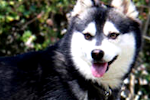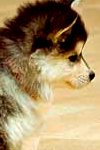Alaskan Klee Kai
 The Alaskan Klee Kai is a northern breed of dog of spitz type. The term "Klee Kai" was derived from Alaskan Athabaskan words meaning "small dog". The breed was developed to create a companion sized version of the Alaskan Husky (a mixed breed of dog used for sled racing), resulting in an energetic, intelligent, apartment-sized dog with an appearance that reflects its northern heritage.
The Alaskan Klee Kai is a northern breed of dog of spitz type. The term "Klee Kai" was derived from Alaskan Athabaskan words meaning "small dog". The breed was developed to create a companion sized version of the Alaskan Husky (a mixed breed of dog used for sled racing), resulting in an energetic, intelligent, apartment-sized dog with an appearance that reflects its northern heritage.
The Alaskan Klee Kai should look like a miniature husky. Although their standard is based on that of the Siberian Husky, there are physical differences, such as a shorter snout, larger ears, and higher tail set, that make them easily distinguishable from the Siberian.
 The Alaskan Klee Kai, like the Siberian Husky, is relatively easy to care for. They are extremely clean. Most don't like wet feet and will spend hours daily grooming themselves. The Alaskan Klee Kai, like many other northern breeds, do not have a typical "doggy odor" or "doggy breath." Most Klee Kai will seldom require a bath. As in Siberians and unlike short haired dogs who shed all year long, the Klee Kai blows their coat twice a year. Of course, the size of the dogs limit the amount of fur blown. It is best to groom the dog on a regular basis during this time. Some of the longer haired dogs can become matted if not groomed. Most Klee Kai will assist the loss of hair by rubbing against things such as fences. Other than this period of blowing coat, the Klee Kai is very self sufficient. The normal preventative measures should be taken, such as trimming of nails, normal grooming in the form of brushing. This process is especially important in the bonding process.
The Alaskan Klee Kai, like the Siberian Husky, is relatively easy to care for. They are extremely clean. Most don't like wet feet and will spend hours daily grooming themselves. The Alaskan Klee Kai, like many other northern breeds, do not have a typical "doggy odor" or "doggy breath." Most Klee Kai will seldom require a bath. As in Siberians and unlike short haired dogs who shed all year long, the Klee Kai blows their coat twice a year. Of course, the size of the dogs limit the amount of fur blown. It is best to groom the dog on a regular basis during this time. Some of the longer haired dogs can become matted if not groomed. Most Klee Kai will assist the loss of hair by rubbing against things such as fences. Other than this period of blowing coat, the Klee Kai is very self sufficient. The normal preventative measures should be taken, such as trimming of nails, normal grooming in the form of brushing. This process is especially important in the bonding process.
 The Alaskan Klee Kai is a highly intelligent, very curious, active, quick and agile little dog that quickly become an integral part of any family that chooses to adopt one. Unlike the Siberian Husky whom they resemble, the Alaskan Klee Kai is standoffish and suspicious of strangers. Because of this they do make extremely good watchdogs. To help them fit better into a society where they must not only tolerate strangers but accept them, socialization must be continual throughout their lives. They are moderately active and have a high prey drive. This means unless they are properly introduced and raised with smaller furry or feathered animals such as rabbits, hamsters, cats, birds, etc, they will hunt and kill them. They can be a great family dog if raised with properly raised children. Alaskan Klee Kai are not likely to tolerate being mistreated (poked at, pinched, bullied) by children and may respond by nipping them, much like the Siberian Husky. Even so, they make great pets. Because of their intelligence they do well in obedience classes and have a high drive to please their owners which helps them to excel in this area as well as many other types of activities. Another such activity is agility in which the AKK almost seems to have been bred to take part in. If you have an Alaskan Klee Kai that is highly active, this is a great way to help them use some of that up.
The Alaskan Klee Kai is a highly intelligent, very curious, active, quick and agile little dog that quickly become an integral part of any family that chooses to adopt one. Unlike the Siberian Husky whom they resemble, the Alaskan Klee Kai is standoffish and suspicious of strangers. Because of this they do make extremely good watchdogs. To help them fit better into a society where they must not only tolerate strangers but accept them, socialization must be continual throughout their lives. They are moderately active and have a high prey drive. This means unless they are properly introduced and raised with smaller furry or feathered animals such as rabbits, hamsters, cats, birds, etc, they will hunt and kill them. They can be a great family dog if raised with properly raised children. Alaskan Klee Kai are not likely to tolerate being mistreated (poked at, pinched, bullied) by children and may respond by nipping them, much like the Siberian Husky. Even so, they make great pets. Because of their intelligence they do well in obedience classes and have a high drive to please their owners which helps them to excel in this area as well as many other types of activities. Another such activity is agility in which the AKK almost seems to have been bred to take part in. If you have an Alaskan Klee Kai that is highly active, this is a great way to help them use some of that up.
 The breed was developed in Wasilla, Alaska during the mid-1970s by Linda S. Spurlin after she observed the result of an accidental mating of an Alaskan Husky and an unknown small dog. The breed was developed with Siberian and Alaskan Huskies using Schipperke and American Eskimo Dog to bring down the size without dwarfism. She bred these dogs in private until she released them to the general public in 1988. Originally called the "Klee Kai", the breed split into "Alaskan Klee Kai" and "Klee Kai" for political reasons in 1995. The breed consolidated under the new name in 2002. The Alaskan Klee Kai was officially recognized by the American Rare Breed Association (ARBA) in 1995 and by the United Kennel Club (UKC) on January 1, 1997.
The breed was developed in Wasilla, Alaska during the mid-1970s by Linda S. Spurlin after she observed the result of an accidental mating of an Alaskan Husky and an unknown small dog. The breed was developed with Siberian and Alaskan Huskies using Schipperke and American Eskimo Dog to bring down the size without dwarfism. She bred these dogs in private until she released them to the general public in 1988. Originally called the "Klee Kai", the breed split into "Alaskan Klee Kai" and "Klee Kai" for political reasons in 1995. The breed consolidated under the new name in 2002. The Alaskan Klee Kai was officially recognized by the American Rare Breed Association (ARBA) in 1995 and by the United Kennel Club (UKC) on January 1, 1997.
--info from wikipedia